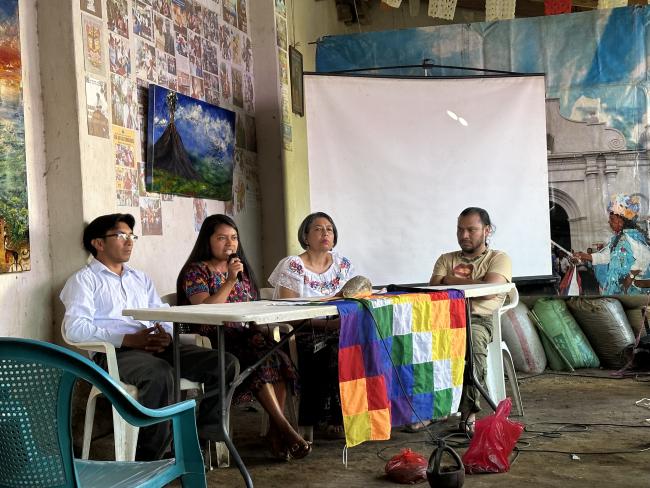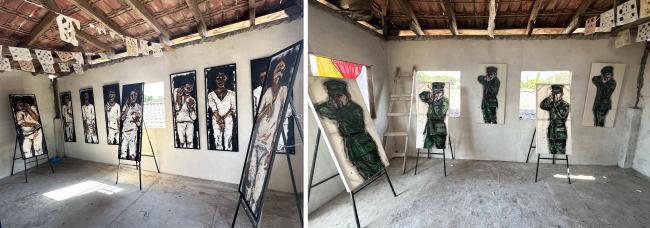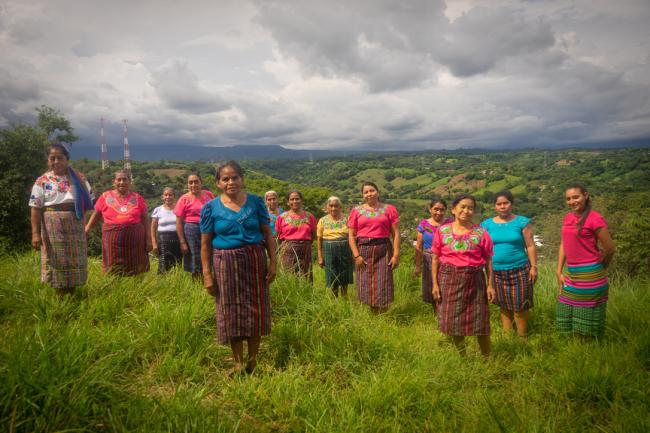
Leer este artículo en español.
In January, the nanzin tamatxtiani (teachers) of the Cuna Nahuat language revitalization program in El Salvador received a call from the Ministry of Education: their program was going to be discontinued. “The [nanzin] called me almost in a panic: ‘what happened with the Cunas? They said they don’t exist!’” said linguist and founder of the Cuna Nahuat program Dr. Jorge Lemus. “It was a shock, truly, a project that was going really well, with good results.”
In the early 2000s, researchers in the United Nations Educational, Scientific, and Cultural Organization (UNESCO) classified the Indigenous Nahuat (or Pipil) language in the category of “severe danger of extinction,” with less than 100 speakers remaining in all of El Salvador. In light of this, in 2003, Lemus and four Nahuat women without any formal education began developing the Cuna Nahuat language revitalization program with the help of Don Bosco University. In 2010, the project began working with the Ministry of Education, which helped fund the project. In Santo Domingo de Guzmán, they launched a Nahuat-only language space to help revitalize, preserve, and promote Indigenous cultural identity.
An integral part of developing the Cuna Nahuat program is that the “community is involved,” said Lemus. “[They] benefit directly from it. It is something that they can identify with.” Prior to Cuna Nahuat, there were approximately only 70 elderly people who spoke the language in the country. Since its opening, Lemus says that 800 children have gone through Cuna Nahuat’s doors with five percent of them proceeding to advanced classes. Groups in Guatemala, Costa Rica, and the United States are also in the process of applying the Cuna revitalization model to their own endangered languages.
Despite the program’s success, the Ministry of Education established their own version called Nests of Linguistic Immersion, which would appropriate Cuna Nahuat’s students, teachers, directors, and curriculum. Rather than an Indigenous community-based program working to revitalize the Nahuat language and culture, the Nests of Linguistic Immersion focus only on language training. Apart from Nahuat, Lemus says, children would have the option to “receive Spanish classes, eventually English, and even Mandarin.” While the government is promoting the Nahuat language and culture by printing new books in the language and transcribing traditional oral stories in Spanish, many of their actions appropriate the efforts of the Indigenous community and overlook the work they have been doing for decades. For example, on the National Day of Nahuat Language, the Vice Minister of Culture Eric Doradea failed to acknowledge the Cuna program that preceded Nests in an interview about the importance of Indigenous culture.
The dismantling of the Cuna Nahuat program is part of a longer history of silence and erasure by the state that extends back to a bloody episode in 1932 where the state slaughtered up to 30,000 Indigenous people in the western part of the country. Many Indigenous people in the following decade renounced or hid their culture out of fear. After the government implemented policies enforcing their assimilation into a generic mestizo race, they seemed to have “disappeared” in El Salvador. It wasn’t until 2014 that, under the leftist party FMLN, the state modified its constitution to recognize Indigenous people in the country. But despite the government’s claims to officially recognize its ancestral peoples, Indigenous communities still face challenges, such as the dismantling of the Cuna Nahuat program, that perpetuate the state’s legacy of cultural erasure.

On January 21, the same month that the Cuna Náhuat program was disbanded, I attended the commemoration of the 1932 massacre, organized by the Indigenous community of Izalco, Sonsonate. As I entered the front gate to the Alcaldía del Común Itzalku (Indigenous mayor’s building) at seven in the morning, I was warmly greeted with two tamales and a cup of coffee made by the madres (mothers) of the community. The open building had no ceiling but had colorful plastic chairs set out in rows on the dirt floor and the walls were decorated with art and posters depicting images of 1932. A YouTube video titled “Caminata de los pueblos originarios en Resistencia” (A Walk of Resistance by Native Communities) played on the projector as people trickled in to fill the seats. Some of the attendees had come from Indigenous communities in Guatemala and Honduras to show their support.
The commemoration’s title, “Rompamos El Silencio! 91 Años (1932-2023)” is a call to action—literally “let’s break the silence”—against the decades of violence and repression inflicted on Indigenous people that the Salvadoran state and its people choose to ignore. It is a silence that has cost thousands of Indigenous lives throughout the 20th century. In what is notoriously known as La Matanza (the Slaughter) of 1932, Indigenous people and communist sympathizers revolted against hacienda landowners because of harsh and unfair working conditions. In response, the military government of General Maximiliano Hernández Martínez sent the National Guard to take back the seized towns. The ensuing months witnessed gruesome violence in the region that resulted in the deaths of up to 30,000 Indigenous people. Survivors’ accounts recall groups of innocent Indigenous people being sprayed by bullets in the town square, soldiers shooting blindly into straw huts, and countless dead bodies left on the streets.
After the 1932 massacre, Indigenous communities began to “disappear.” For fear of being executed, shamed, or linked to communism, the Indigenous population “self-dissolved,” abandoning their native dress and language. Large plots of Indigenous people’s lands were transferred to ladinos (people of mixed race), especially land owned by Indigenous men who were killed during the massacre; in other cases, ladinos tricked illiterate native widows into giving them their land titles for purported safekeeping. At the national level, in 1933, the administration of Hernández Martínez passed a series of restrictive migration laws that prohibited the migration of people from any non-white European countries in an attempt to foster national unity through the creation of a mestizo race. Then, in 1941, the government excluded Indigenous as an ethnic category in the national census. In the eyes of the state and public, therefore, Indigenous people ceased to exist in the country, becoming conflated into the lower peasant class.

Despite the state’s attempts at erasure and Indigenous communities' efforts to hide their culture out of self-preservation, Indigenous activists continued to fight for political recognition throughout the mid 20th century. In 1954, for example, cacique Adrián Esquino Lisco and Andrés Refugio Sánchez Ramírez founded the Asociación Nacional de Indígenas de El Salvador (ANIS) to fight for the recognition of Indigenous land titles under Salvadoran law. To generate international attention, Esquino Lisco attended Indigenous people’s conferences around the world in the late 1970s. Then in 1980, the Salvadoran civil war broke out, and the government used the conflict to conceal violence against ANIS leaders. On February 22, 1983, for example, a paramilitary squad in collusion with the rightwing Nationalist Republican Alliance party (ARENA) massacred 74 members of ANIS in Las Hojas, Sonsonate. To bring national attention to the incident, Esquino Lisco posted bulletins in various newspapers, proclaiming that the government had targeted the Indigenous village in the western part of El Salvador, detained 74 men, tied their thumbs behind their backs, and shot them in the back of the head. Despite his efforts however, the massacre of Las Hojas is not formally recognized as an Indigenous massacre. Even the United Nations 1993 Truth Commission of El Salvador, widely considered an important milestone, refers to the 74 Indigenous members of ANIS killed in Las Hojas as merely peasants.
As recently as 1995, El Salvador denied the existence of its Indigenous peoples. A report to the United Nations Committee on the Elimination of Racial Discrimination declared: “The Government wishes to state plainly and categorically that the population does not comprise definite groups with differing racial characteristics and that, consequently, there is no kind of discrimination on grounds of race in El Salvador…El Salvador does not have any significant population groups possessing characteristics that clearly distinguish them from the population as a whole…[the] Salvadoran society does not have any problem of ethnic populations.” The document only mentions Indigenous people twice—both in relation to the Spanish conquest—omitting that the state was responsible for the death of tens of thousands of Indigenous people in 1932. It wasn’t until 2014, four years after the Cuna Nahuat program was created, that the Salvadoran state officially reformed its constitution to recognize Indigenous peoples and “the importance of adopting policies to maintain their ethnic and cultural identity, values, and spirituality.”
Despite the government finally recognizing Indigenous people in 2014, Lemus believes that the state has only done the bare minimum to preserve Indigenous cultures in El Salvador. Since the revitalization program’s initial stages in 2003, the government has provided and withdrawn their financial support as it was convenient to them. The defunding of the Cuna Nahuat language program comes within the context of an increasingly authoritarian state. For over a year, El Salvador has been under a state of exception that has stripped its citizens of their constitutional rights and arrested over 65,000 people. Additionally, the current president, Nayib Bukele, is unconstitutionally running for election again in 2024. Since coming into office in 2019, Bukele has shown a reluctance to recognize the state’s responsibility for the terror inflicted on scores of rural people during the civil war (1980-1992). While there are a few recognized examples of ethnically motivated violence during the war, the lack of official records after 1932 makes it difficult for researchers and activists to point to a pattern of Indigenous targeting and make a case for reparations. These decades of erasure also complicate the process of identifying how contemporary policies are particularly impacting Indigenous people now. Although the current government may not be explicitly targeting Indigenous people, more subtle policies, such as the defunding of Cuna Nahuat, reveal how the government continues to suppress and overlook important feats Indigenous people have achieved despite suffering decades of disregard, discrimination, and murder at the hands of the state.

Indigenous communities in El Salvador nevertheless continue to show forms of resistance and resilience. On February 6, 2023, a week after being notified that the Cuna Nahuat program was going to be discontinued, the Indigenous community in Santo Domingo de Guzman, with the help of Lemus, reestablished it. The program now receives financial support from the El Salvador ElKartasuna Collective, the University of Alberta in Canada, UNESCO, UNICEF, and the Salvadoran diaspora in the United States.
The reinstalment of the program, however, is just one front in a larger battle for recognition and rights for El Salvador's Indigenous communities. Lemus believes that “uniting as one [Indigenous] community and fighting with one voice is needed in El Salvador” to continue pushing broader Indigenous efforts, including the continuation of the Cuna Nahuat program. “It’s an incredible demonstration of how a community can resist against a greater power, state power,” says Lemus. And the only way to break the silence is together.
Kevin Ramírez is a PhD Candidate in Latin American and Caribbean History at New York University studying Salvadoran Indigenous communities in the 20th century. His work sheds light on the overlooked Indigenous history in El Salvador by examining the relationship between La Matanza of 1932 and the 1980s civil war.

